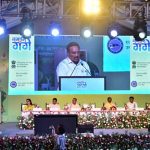New Delhi, May 21The 63rd Executive Committee meeting of the National Mission for Clean Ganga was arranged as part of a tangible and comprehensive effort to revitalize the Ganga and its tributaries. The meeting’s main focus was sustainability and innovation, which are entirely consistent with the mission’s main goals, which include restoring the Ganga basin’s environment, enhancing water quality, and managing urban water sustainably.
This time, a number of initiatives were accepted, including plans for rejuvenation, scientific research, technology solutions, and infrastructural projects. In order to ensure that rivers and other bodies of water continue to exist in a safe manner for future generations, their goal goes beyond making improvements in the short term.
A sewage management project for ₹126.41 crore was approved during the meeting for the historic city of Agra, Uttar Pradesh. Along with 21.20 kilometers of interception and diversion sewer lines, 40 interception and diversion structures will be built as part of this project. To further safeguard water sources from pollution, eight contemporary pumping stations will be erected, and five large drains will have efficient trash screens. This project is a long-term, technically and managerially significant solution because it is founded on the Design-Build-Operate-Transfer approach.
The committee authorized two significant projects to foster a thorough understanding of environmental flow: “Environmental Flow Assessment of Kosi, Gandak, and Mahananda Rivers,” which had a budget of about ₹6 crore, and “Environmental Flow Assessment in Ghaghara and Gomti River Basins,” which was estimated to cost about ₹8 crore. Over the next three years, these two projects will open the door for the creation of adaptable and sustainable river flow regimes.
Additionally, a study was allowed to monitor the efficacy and provide standards for the household wastewater treatment of Johkasou technology and other small plug-and-play technologies. The purpose of this project is to improve the sustainability and quality of on-site sewage treatment in India.
With a two-year budget of Rs 2.47 crore, the project “Conservation and Management of Ramsar Site ‘Asan Wetland’ in Dehradun District of Uttarakhand” was authorized at the conference. Restoring the wetland’s ecological health and biodiversity is the aim of this project. It covers planning the conservation measures as well as approving the creation of wetland inventory, evaluation, and monitoring systems.
The meeting saw the participation of key officials, including: Rajeev Kumar Mital (Director General, NMCG), Mahavir Prasad (Joint Secretary, Ministry of Power), Nalin Srivastava (Deputy Director General, NMCG), Anup Kumar Srivastava, Executive Director (Technical), Brijendra Swaroop Executive Director (Project), S.P. Vashishtha Executive Director (Administration), Bhaskar Dasgupta Executive Director (Finance), Nandini Ghosh, (Project Director of West Bengal), Prabhash Kumar (Additional Project Director from Uttar Pradesh SMCG), Dr. Ramakant Pandey, Managing Director UP Jal Nigam (Urban).


